Effect of a Fibroin Enzymatic Hydrolysate on Memory Improvement: A Placebo-Controlled, Double-Blind Study
Abstract
:1. Introduction
2. Materials and Methods
2.1. Study Material
2.2. Study Subjects
2.3. Treatment
2.4. Assessment
2.5. Statistical Analysis
3. Results
3.1. Subject Demographics
3.2. Effects of FPEH on Memory Quotient of Rey–Kim Memory Test
3.3. Effects of FPEH on Learning Gradient of Rey–Kim Memory Test (KAVLT)
3.4. Effects of FPEH on Memory Retention of Rey–Kim Memory Test
3.5. Effects of FPEH on Retrieval Efficiency of Rey–Kim Memory Test
3.6. Effects of FPEH on Visuospatial Abilities, Attention and Memory (Executive Functions)
3.7. Side Effects
4. Discussion
Acknowledgments
Author Contributions
Conflicts of Interest
References
- Kato, N.; Kayashita, J.; Sasaki, M. Physiological functions of buckwheat protein and sericin as resistant proteins. J. Jpn. Soc. Food Sci. 2000, 53, 71–75. [Google Scholar] [CrossRef]
- Yang, Y.; Tang, L.; Ting, L.; Liu, H. Silkworms culture as a source of protein for humans in space. Adv. Space Res. 2009, 43, 1236–1242. [Google Scholar] [CrossRef]
- Gosline, J.M.; Guerette, P.A.; Ortlepp, C.S.; Savage, K.N. The mechanical design of spider silks: From fibroin sequence to mechanical function. J. Exp. Biol. 1999, 202, 3295–3303. [Google Scholar] [PubMed]
- Hu, X.; Vasanthavada, K.; Kohler, K.; McNary, S.; Moore, A.M.; Vierra, C.A. Molecular mechanisms of spider silk. Cell. Mol. Life Sci. 2006, 63, 1986–1999. [Google Scholar] [CrossRef] [PubMed]
- Chae, H.S.; Kang, Y.K.; Shin, Y.K.; Lee, H.J.; Yu, J.I.; Lee, K.G.; Yeo, J.H.; Kim, Y.S.; Sohn, D.S.; Kim, K.Y.; et al. The role of BF-7 on neuroprotection and enhancement of cognitive function. Korean J. Physiol. Pharmacol. 2004, 8, 173–179. [Google Scholar]
- Kim, D.K.; Lee, J.Y.; Sung, J.J.; Kim, E.T.; Kim, Y.S.; Kwon, O.S.; Yun, Y.C.; Lee, T.J.; Kang, Y.K.; Chung, Y.; et al. The role of BF-7 on enhancement of memory and cognitive function. Korean J. Anat. 2004, 37, 519–527. (In Korean) [Google Scholar]
- Kim, K.; Park, S.; Yoo, H.K.; Lee, J.Y.; Jung, H.Y.; Kim, D.H.; Lee, H.J.; Kim, J.Y.; Young, Y.C.; Marshall, M.R.; et al. Brain Factor-7 extracted from Bombyx mori enhances cognition and attention in normal children. J. Med. Food 2009, 12, 643–648. [Google Scholar] [CrossRef] [PubMed]
- Kim, D.H.; Kim, O.H.; Yeo, J.H.; Lee, K.G.; Park, G.D.; Kim, D.J.; Chung, Y.H.; Kim, K.Y.; Lee, W.B.; Youn, Y.C.; et al. The improvement of short- and long-term memory of young children by BF-7. J. Korean Soc. Food Sci. Nutr. 2010, 39, 376–382. (In Korean) [Google Scholar] [CrossRef]
- Lee, S.H.; Kim, Y.S.; Kim, S.S.; Kang, Y.K.; Lee, M.Y.; Lee, K.G.; Yeo, J.H.; Lee, W.B.; Kim, D.Y. Association between cerebral blood flow and cognitive improvement effect by B. mori extracted compound. Korean J. Seric. Sci. 2004, 46, 77–79. (In Korean) [Google Scholar]
- Lee, M.Y.; Lee, S.H.; Lee, J.S.; Min, K.J.; Lee, K.G.; Yeo, J.H.; Kwon, H.J.; Lee, J.K.; Kang, Y.K.; Lee, D.Y.; et al. BF-7 improved memory function and protected neurons from oxidative stress. Korean J. Phys. Anthropol. 2004, 17, 313–320. [Google Scholar] [CrossRef]
- Yeo, J.H.; Park, K.H.; Ju, W.C.; Lee, J.A.; Lee, K.G.; Woo, S.O.; Han, S.M.; Kweon, H.Y.; Kim, S.S.; Cho, Y.H. Inhibitory effect of conditioned medium of silk fibroin-treated osteoblasts in osteoclast differentiation. J. Korean Soc. Food Sci. Nutr. 2008, 37, 992–997. (In Korean) [Google Scholar] [CrossRef]
- Yeo, J.H.; Lee, K.; Kweon, H.J.Y.; Woo, S.O.; Han, S.M.; Lee, Y.W.; Kim, J.I.; Kim, S.S.; Demura, M. Cognitive ability enhancement effects in rats by S. mori fibroin by enzymatic hydrolysis. Korean J. Seric. Sci. 2004, 46, 23–27. (In Korean) [Google Scholar]
- Kim, H. Rey-Kim Memory Test; Neuropsychology Press: Seoul, Korea, 1999. [Google Scholar]
- Kim, H.K. Assessment of memory disorders using Rey-Kim Memory Test. J. Rehabilit. Psychol. 2001, 8, 29–48. [Google Scholar]
- Lezak, M.D. Neuropsychological Assessment; Oxford University Press: New York, NY, USA, 1983. [Google Scholar]
- Albers, C.; Lakens, D. Biased sample size estimates in a-priori power analysis due to the choice of effect size index and follow-up bias. J. Exp. Soc. Psychol. 2017. [Google Scholar] [CrossRef]
- Deibel, S.H.; Zelinski, E.L.; Keeley, O.; McDonald, R.J. Epigenetic alterations in the suprachiasmatic nucleus and hippocampus contribute to age-related cognitive decline. Oncotarget 2015, 6, 181–203. [Google Scholar] [CrossRef] [PubMed]
- Shin, M.S.; Park, S.Y.; Park, S.R.; Seol, S.H.; Kwon, J.S. Clinical and empirical applications of the Rey-Osterrieth Complex Figure Test. Nat. Protoc. 2006, 1, 892–899. [Google Scholar] [CrossRef] [PubMed]
- Boone, K.B.; Lesser, I.M.; Hill-Gutierrez, E.; Berman, N.G.; D’Elia, L.F. Rey-Osterrieth complex figure performance in healthy, older adults: Relationship to age, education, sex and IQ. Clin. Neuropsychol. 1993, 7, 22–28. [Google Scholar] [CrossRef]
- Delaney, R.C.; Prevey, M.L.; Cramer, J.; Mattson, R.H. VA Epilepsy Cooperative Study #264 Research Group. Test-retest comparability and control subject data for the rey-auditory verbal learning test and rey-osterrieth/taylor complex figures. Arch. Clin. Neuropsychol. 1992, 7, 523–528. [Google Scholar] [PubMed]
- De Jager, C.A.; Dye, L.; de Bruin, E.A.; Butler, L.; Fletcher, J.; Lamport, D.J.; Latulippe, M.A.; Spencer, J.P.E.; Wesnes, K. Criteria for validation and selection of cognitive tests for investigating the effects of foods and nutrients. Nutr. Rev. 2014, 72, 162–179. [Google Scholar] [CrossRef] [PubMed]
- Fastenau, P.S.; Denburg, N.L.; Hufford, B.J. Adult norms for the Rey-Osterrieth Complex Figure Test and for supplemental recognition and matching trials from the Extended Complex Figure Test. Clin. Neuropsychol. 1999, 13, 30–47. [Google Scholar] [CrossRef] [PubMed]
- Butler, M.; Nelson, V.A.; Davila, H.; Ratner, E.; Fink, H.A.; Hemmy, L.S.; McCarten, J.R.; Barclay, T.R.; Brasure, M.; Kane, R.L. Over-the-counter supplement interventions to prevent cognitive decline, mild cognitive impairment, and clinical Alzheimer-type dementia: A systematic review. Ann. Intern. Med. 2018, 168, 52–63. [Google Scholar] [CrossRef] [PubMed]
- Cheng, P.F.; Chen, J.J.; Zhou, X.Y.; Ren, Y.F.; Huang, W.; Zhou, J.J.; Xie, P. Do soy isoflavones improve cognitive function in postmenopausal women? A meta-analysis. Menopause 2015, 22, 198–206. [Google Scholar] [CrossRef] [PubMed]
- Fink, H.A.; Jutkowitz, E.; McCarten, J.R.; Hemmy, L.S.; Butler, M.; Davila, H.; Ratner, E.; Calvert, C.; Barclay, T.R.; Brasure, M.; et al. Pharmacologic interventions to prevent cognitive Decline, mild cognitive impairment, and clinical Alzheimer-type dementia: A systematic review. Ann. Intern. Med. 2018, 168, 39–51. [Google Scholar] [CrossRef] [PubMed]
- Gareri, P.; Castagna, A.; Cotroneo, A.M.; Putignano, S.; De Sarro, G.; bruni, A.C. The role of citicoline in cognitive impairment: Pharmacological characteristics, possible advantages, and doubts for an old drug with new perspectives. Clin. Interv. Aging 2015, 3, 1421–1429. [Google Scholar] [CrossRef] [PubMed]
- Geng, J.; Dong, N.H.; Lee, M.S.; Wu, T.; Jiang, K.; Zhou, A.L.; Malouf, R. Ginseng for cognition. Cochrane Database Syst. Rev. 2010. [Google Scholar] [CrossRef] [PubMed]
- Kane, R.L.; Butler, M.; Fink, H.A.; Brasure, M.; Davila, H.; Desai, P.; Jutkowitz, E.; McCreedy, E.; Nelson, V.A.; McCarten, J.R.; et al. Interventions to Prevent Age-Related Cognitive Decline, Mild Cognitive Impairment, and Clinical Alzheimer’s-Type Dementia; Comparative Effectiveness Review No. 188; (Prepared by the Minnesota Evidence-based Practice Center under Contract No. 290-2015-00008-I.) AHRQ Publication No. 17-EHC008-EF; Agency for Healthcare Research and Quality: Rockville, MD, USA, 2017.
- Mikkelsen, K.; Stojanovska, L.; Tangalakis, K.; Bosevski, M.; Apostolopoulos, V. Cognitive decline: A vitamin B perspective. Maturitas 2016, 93, 108–113. [Google Scholar] [CrossRef] [PubMed]
- Oliynyk, S.; Oh, S. Actoprotective effect of ginseng: Improving mental and physical performance. J. Ginseng Res. 2013, 37, 144–166. [Google Scholar] [CrossRef] [PubMed]
- Puttarak, P.; Dilokthornsakul, P.; Saokaew, S.; Dhippayom, T.; Kongkaew, C.; Sruamsiri, R.; Chuthaputti, A.; Chaiyakunapruk, N. Effects of Centella asiatica (L.) Urb. On cognitive function and mood related outsomes: A systematic review and meta-analysis. Sci. Rep. 2017, 7, 10646–10658. [Google Scholar] [CrossRef] [PubMed]
- Yurko-Mauro, K. Cognitive and cardiovascular benefits of docosahexaenoic acid in aging and cognitive decline. Curr. Alzheimer Res. 2010, 7, 190–196. [Google Scholar] [CrossRef] [PubMed]
- Traini, E.; Bramanti, V.; Amenta, F. Choloine alphoscerate (alpha-glyceryl-phosphoryl-choline) an old choline-containing phospholipid with a still interesting profile as cognition enhancing agent. Curr. Alzheimer Res. 2013, 19, 1070–1079. [Google Scholar] [CrossRef]
- Moran, D.L.; Underwood, M.Y.; Gabourie, T.A.; Lerner, K.C. Effects of a supplement containing Apoaequorin on verbal learning in older adults in the community. Adv. Mind Body Med. 2016, 30, 4–11. [Google Scholar] [PubMed]
- Kean, J.D.; Downey, L.A.; Stigu, C. A systematic review of the Ayurvedic medicinal herb Bacopa monnieri in child and adolescent populations. Complement. Ther. Med. 2016, 29, 56–62. [Google Scholar] [CrossRef] [PubMed]
- Kean, J.D.; Downey, L.A.; Stough, C. Systematic overview of Bacopa monnieri (L.) Wettst. Dominant poly-herbal formulas in children and adolescents. Medicines 2017, 4. [Google Scholar] [CrossRef] [PubMed]
- Kongkaew, C.; Dilokthornsakul, P.; Thanarangsarit, P.; Limpeanchob, N.; Scholfield, C.N. Meta-analysis of randomized controlled trials on cognitive effects of Bacopa monnieri extract. J. Ethnopharmacol. 2014, 151, 528–535. [Google Scholar] [CrossRef] [PubMed]
- Pase, M.P.; Kean, J.; Sarris, J.; Neale, C.; Scholey, A.B.; Stough, C. The cognitive-enhancing effects of Bacopa monnieri: A systematic review of randomized, controlled human clinical trials. J. Altern. Complement. Med. 2012, 18, 647–652. [Google Scholar] [CrossRef] [PubMed]
- Vakhapova, V.; Coghne, T.; Richter, Y.; Herzog, Y.; Korczyn, A.D. Phosphatidylserine containing omega-3 fatty acids may improve memory abilities in non-demented elderly with memory complaints: A double-blind placebo-controlled trials. Dement. Geriatr. Cogn. Disord. 2010, 29, 467–474. [Google Scholar] [CrossRef] [PubMed]
- Choi, G.H.; Jo, M.N.; Mon, S.H.; Lim, S.M.; Jung, A.; Kweon, Y.C.; Paik, H.D. Neuroprotective effects and physiochemical characteristics of milk fortified with fibroin BF-7. Korean J. Food Sci. Anim. Resour. 2008, 28, 431–436. [Google Scholar] [CrossRef]
- Karran, E.; De Strooper, B. The amyloid cascade hypothesis: Are we poised for success or failure? J. Neurochem. 2016, 139 (Suppl. 2), 237–252. [Google Scholar] [CrossRef] [PubMed]
- Lee, D.Y.; Yun, J.Y.; Kim, J.I.; Kim, D.H.; Han, I.S.; Lee, W.B. Protective effect of fibroin BF-7 on neuronal cell death in Alzheimer model using amyloid β peptide. Korean J. Anat. 2007, 40, 57–67. [Google Scholar]
- Morley, J.E.; Farr, S.A. The role of amyloid-beta in the regulation of memory. Biochem. Pharmacol. 2014, 88, 479–485. [Google Scholar] [CrossRef] [PubMed]
- Xekardaki, A.; Kovari, E.; Gold, G.; Papadimitropoulou, A.; Giacobini, E.; Hermann, F.; Giannakopoulos, P.; Bouras, C. Neuropathological changes in aging brain. Adv. Exp. Med. Biol. 2015, 821, 11–17. [Google Scholar] [PubMed]
- Adessi, C.; Soto, C. Beta-sheet breaker strategy for the treatment of Alzheimer’s disease. Drug Dev. Res. 2002, 56, 184–193. [Google Scholar] [CrossRef]
- Viet, M.H.; Ngo, S.T.; Lam, N.S.; Li, M.A. Inhibition of aggregation of amyloid peptides by beta-sheet breaker peptides and their binding affinity. J. Phys. Chem. B 2011, 115, 7433–7446. [Google Scholar] [CrossRef] [PubMed]
- Parthsarathy, V.; McCLean, P.L.; Holscher, C.; Taylor, M.; Tinker, C.; Jones, G.; Kolosov, O.; Salvati, E.; Gregori, M.; Masserini, M.; et al. A novel retro-inverso peptide inhibitor reduces amyloid deposition, oxidation and inflammation and stimulates neurogenesis in the APPswe/PS1deltaE9 mouse model of Alzheimers Disease. PLoS ONE 2013, 8, e54769. [Google Scholar] [CrossRef]
- Yuan, W.; Wang, J.; Zhou, F. In vivo hypotensive and physiological effects of a silk fibroin hydrolysate on spontaneously hypertensive rats. Biosci. Biotechnol. Biochem. 2013, 76, 1987–1989. [Google Scholar] [CrossRef] [PubMed]
- Hyun, C.K.; Kim, Y.I.; Frost, S.C. Soluble fibroin enhances insulin sensitivity and glucose metabolism in 3T3-Li adipocytes. J. Nutr. 2004, 134, 3257–3263. [Google Scholar] [CrossRef] [PubMed]
- Do, S.G.; Park, J.H.; Nam, H.; Kim, J.B.; Lee, J.Y.; Oh, Y.S.; Suh, J.G. Silk fibroin hydrolysate exerts an anti-diabetic effect by increasing pancreatic β cell mass in C57BL/KsJ-db/db mice. J. Vet. Sci. 2013, 13, 339–344. [Google Scholar] [CrossRef]
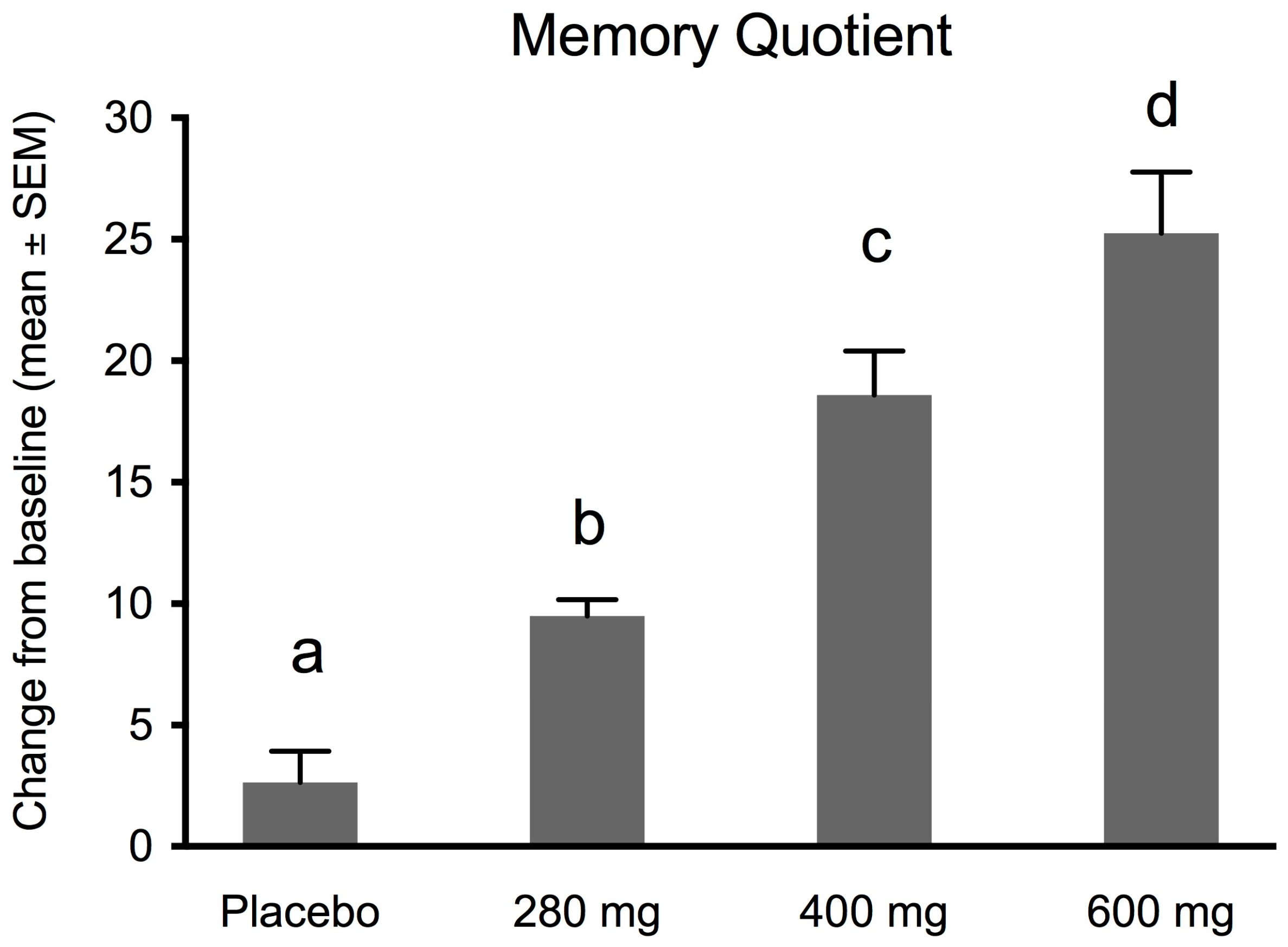
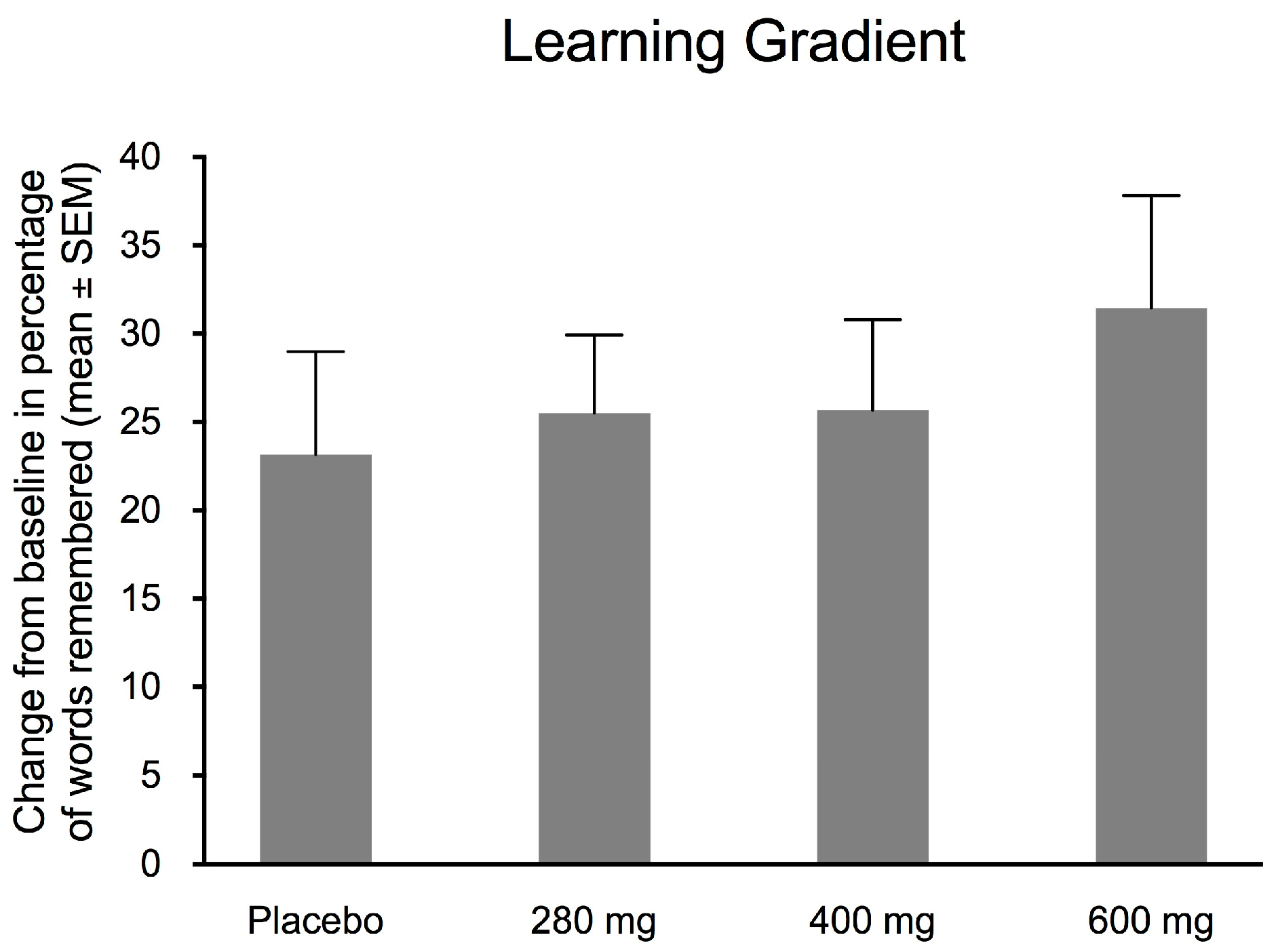

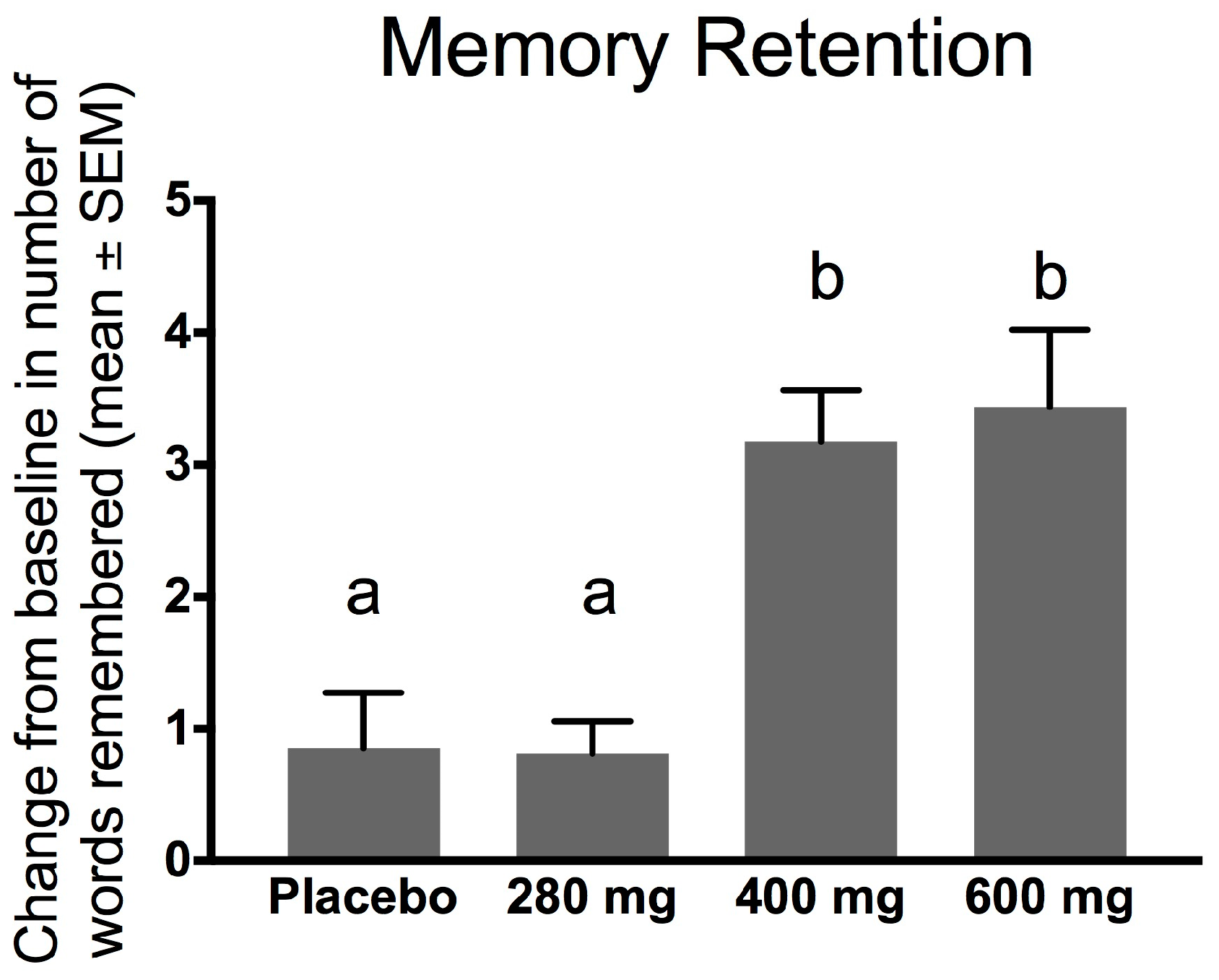
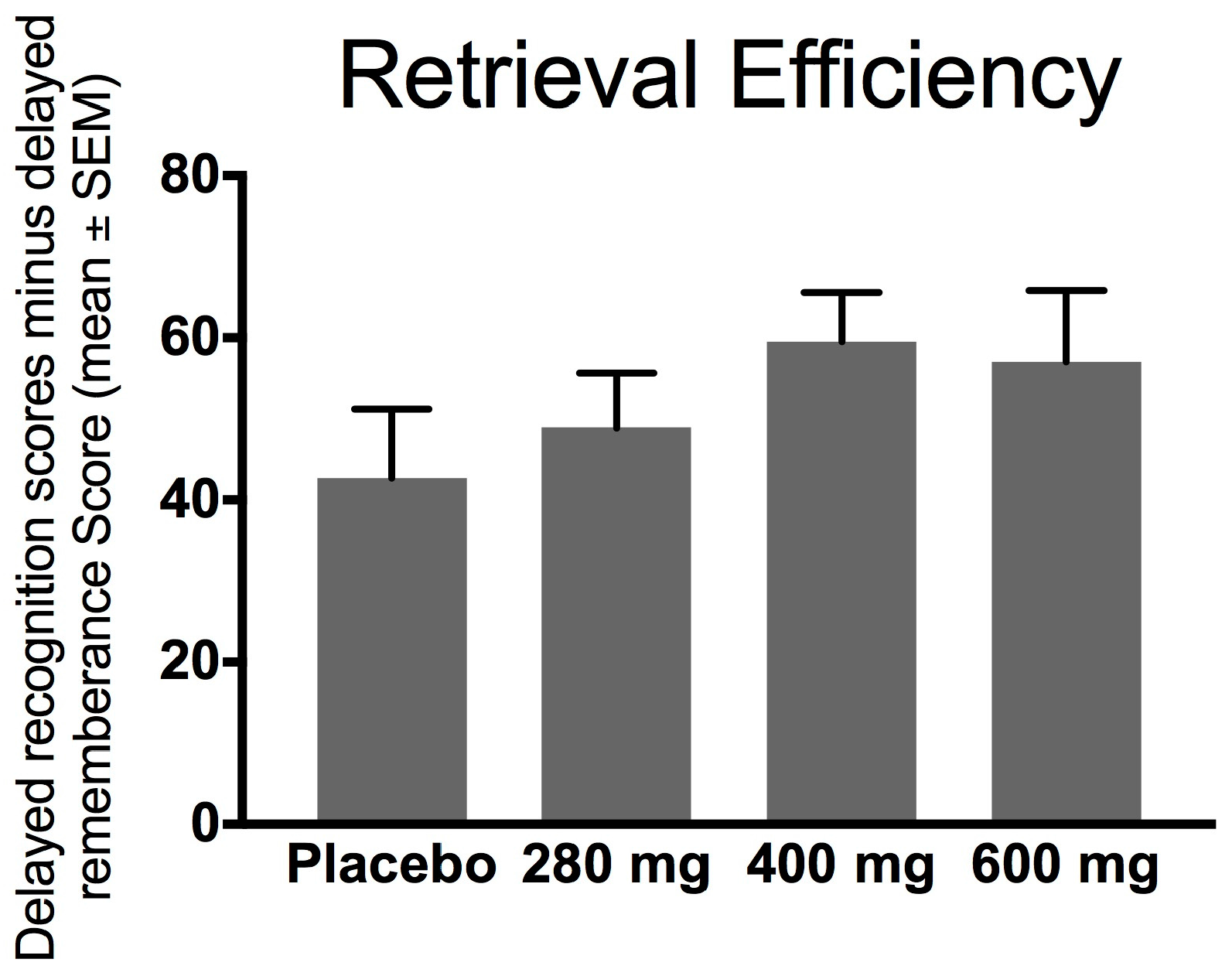
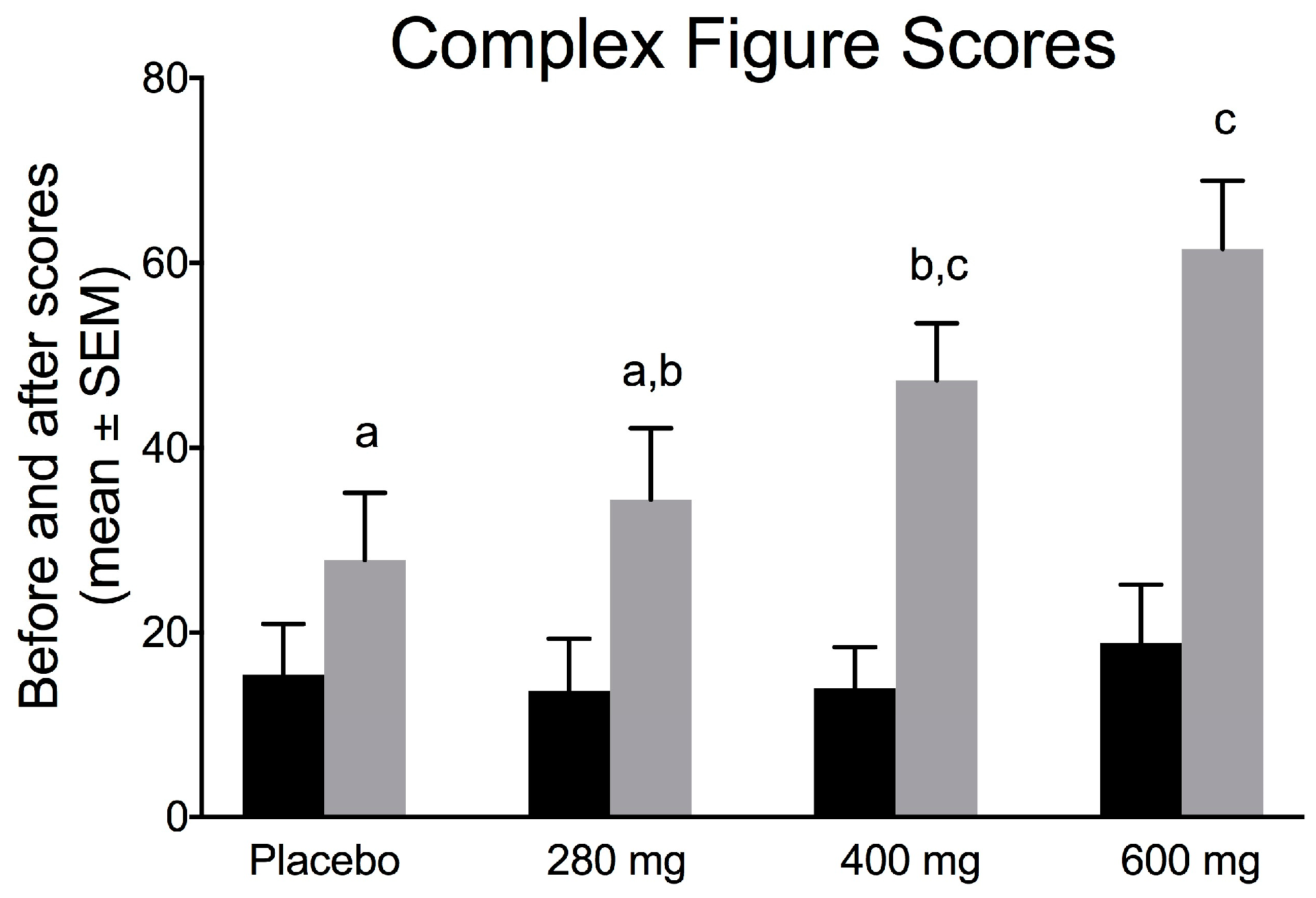
© 2018 by the authors. Licensee MDPI, Basel, Switzerland. This article is an open access article distributed under the terms and conditions of the Creative Commons Attribution (CC BY) license (http://creativecommons.org/licenses/by/4.0/).
Share and Cite
Kang, Y.K.; Lee, B.Y.; Bucci, L.R.; Stohs, S.J. Effect of a Fibroin Enzymatic Hydrolysate on Memory Improvement: A Placebo-Controlled, Double-Blind Study. Nutrients 2018, 10, 233. https://doi.org/10.3390/nu10020233
Kang YK, Lee BY, Bucci LR, Stohs SJ. Effect of a Fibroin Enzymatic Hydrolysate on Memory Improvement: A Placebo-Controlled, Double-Blind Study. Nutrients. 2018; 10(2):233. https://doi.org/10.3390/nu10020233
Chicago/Turabian StyleKang, Yong Koo, Boo Yong Lee, Luke R. Bucci, and Sidney J. Stohs. 2018. "Effect of a Fibroin Enzymatic Hydrolysate on Memory Improvement: A Placebo-Controlled, Double-Blind Study" Nutrients 10, no. 2: 233. https://doi.org/10.3390/nu10020233



